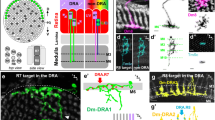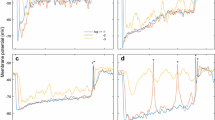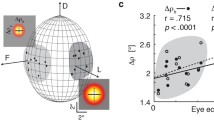Abstract
Using the combined Golgi-electron microscopy technique, we have determined the three-dimensional dendritic fields of the short visual fibres (svf 1–3) and first-order interneurons or L-fibres (L1-4) within the first optic ganglion (lamina) of the nocturnal bee Megalopta genalis. Serial cross sections have revealed that the svf type 2 branches into one adjacent neural unit (cartridge) in layer A, the most distal of the three lamina layers A, B and C. All L-fibres, except L1-a, exhibit wide lateral branching into several neighbouring cartridges. L1-b shows a dendritic field of seven cartridges in layers A and C, dendrites of L2 target 13 cartridges in layer A, L3 branches over a total of 12 cartridges in layer A and three in layer C and L4 has the largest dendritic field size of 18 cartridges in layer C. The number of cartridges reached by the respective L-fibres is distinctly greater in the nocturnal bee than in the worker honeybee and is larger than could be estimated from our previous Golgi-light microscopy study. The extreme dorso-ventrally oriented dendritic field of L4 in M. genalis may, in addition to its potential role in spatial summation, be involved in edge detection. Thus, we have shown that the amount of lateral spreading present in the lamina provides the anatomical basis for the required spatial summation. Theoretical and future physiological work should further elucidate the roles that this lateral spreading plays to improve dim-light vision in nocturnal insects.




Similar content being viewed by others
References
Burgett DM, Sukumalanand P (2000) Flight activity of Xylocopa (Nyctomelitta) tranquebarica: a night flying carpenter bee (Hymenoptera: Apidae). J Apic Res 39:75–83
Cockerell TDA (1923) Two nocturnal bees and a minute Perdita. Am Mus Novit 66:1–4
Cronin TW, Jarvilehto M, Weckstrom M, Lall AB (2000) Tuning of photoreceptor spectral sensitivity in fireflies (Coleoptera: Lampyridae). J Comp Physiol [A] 186:1–12
Greiner B, Ribi WA, Wcislo WT, Warrant EJ (2004a) Neural organisation in the first optic ganglion of the nocturnal bee Megalopta genalis. Cell Tissue Res 318:429–437
Greiner B, Ribi WA, Warrant EJ (2004b) Retinal and optical adaptations for nocturnal vision in the halictid bee Megalopta genalis. Cell Tissue Res 316:377–390
Kelber A, Balkenius A, Warrant EJ (2002) Scotopic colour vision in nocturnal hawkmoths. Nature 419:922–925
Kerfoot WB (1967) The lunar periodicity of Sphecodogastra texana, a nocturnal bee. Anim Behav 15:479–486
Kien J, Menzel R (1977a) Chromatic properties of interneurons in the optic lobes of the bee. I. Broad band neurons. J Comp Physiol 113:17–34
Kien J, Menzel R (1977b) Chromatic properties of interneurons in the optic lobes of the bee. II. Narrow band and colour opponent neurons. J Comp Physiol 113:35–53
Land MF (1981) Optics and vision in invertebrates. In: Autrum H (ed) Handbook of sensory physiology, vol 7/6B. Vision in invertebrates. Springer, Berlin Heidelberg New York, pp 471–592
Land MF, Nilsson D-E (2002) Animal eyes. Oxford University Press, New York
Lythgoe NJ (1979) The ecology of vision. Oxford University Press, New York
Menzel R (1974) Spectral sensitivity of monopolar cells in the bee lamina. J Comp Physiol 93:337–346
Menzel R, Blakers M (1976) Colour receptors in the bee eye-morphology and spectral sensitivity. J Comp Physiol 108:11–33
Nilsson D-E (1989) Optics and evolution of the compound eye. In: Stavenga DG, Hardie R (eds) Facets of vision. Springer, Berlin Heidelberg New York, pp 30–73
Ribi WA (1976) The first optic ganglion of the bee. II. Topographical relationships of the monopolar cells within and between cartridges. Cell Tissue Res 171:359–373
Ribi WA (1981) The first optic ganglion of the bee. IV. Synaptic fine structure and connectivity patterns of receptor cell axons and first order interneurones. Cell Tissue Res 215:443–464
Ribi WA (1983a) Combined Golgi and electron microscopy techniques. In: Miller TA (ed) Experimental entomology, vol II: neuroanatomical techniques. Springer, Berlin Heidelberg New York, pp 1–18
Ribi WA (1983b) Electron microscopy of Golgi-impregnated neurons. In: Strausfeld NJ (ed) Functional neuroanatomy. Springer, Berlin Heidelberg New York Tokyo, pp 1–18
Ribi WA (1987a) Anatomical identification of spectral receptor types in the retina and lamina of the Australian orchard butterfly, Papilio aegeus aegeus D. Cell Tissue Res 247:393–407
Ribi WA (1987b) The structural basis of information processing in the visual system of the bee. In: Menzel R, Mercer A (eds) Neurobiology and behavior of honeybees. Springer, Berlin Heidelberg New York, pp 130–140
Roubik DW (1989) Ecology and natural history of tropical bees. Cambridge University Press, Cambridge
Warrant EJ (1999) Seeing better at night: life style, eye design and the optimum strategy of spatial and temporal summation. Vis Res 39:1611–1630
Warrant EJ (2004) Vision in the dimmest habitats on earth. J Comp Physiol [A] 190:765–789
Warrant EJ, McIntyre PD (1993) Arthropod eye design and the physical limits to spatial resolving power. Prog Neurobiol 40:413–461
Warrant E, Porombka T, Kirchner WH (1996) Neural image enhancement allows honeybees to see at night. Proc R Soc Lond [Biol] 263:1521–1526
Warrant EJ, Kelber A, Gislen A, Greiner B, Ribi W, Wcislo WT (2004) Nocturnal vision and landmark orientation in a tropical halictid bee. Curr Biol 14:1309–1318
Waters DA (2003) Bats and moths: what is there left to learn? Physiol Entomol 28:237–250
Wcislo WT, Arneson L, Roesch K, Gonzales V, Smith A, Fernández H (2004) The evolution of nocturnal behaviour in sweat bees, Megalopta genalis and M. ecuadoria (Hymenoptera: Halictidae): an escape from competitors and enemies? Biol J Linn Soc 83:377–387
Acknowledgements
We thank Megan O'Connor and two anonymous reviewers for critically reading the manuscript, Victor Gonzales, Andre Riveros and Mark Holdstock for assistance with fieldwork, William Wcislo and the staff of the Smithsonian Tropical Research Institute (STRI) for their help and the Autoridad Nacional del Ambiente of the Republic of Panama for permission to export bees. The histological work was partly carried out by B.G. at the Center for Visual Sciences, Research School of Biological Sciences, Australian National University, Canberra.
Author information
Authors and Affiliations
Corresponding author
Additional information
B.G. is grateful for grants from the Royal Physiographic Society, the Per Westlings Fond, the Foundation of Dagny and Eilert Ekvall and the Royal Swedish Academy of Sciences. E.J.W. would like to thank the Smithsonian Tropical Research Insitute, the Swedish Research Council, the Crafoord Foundation, the Wenner-Gren Foundation and the Royal Physiographic Society of Lund for their ongoing support.
Rights and permissions
About this article
Cite this article
Greiner, B., Ribi, W.A. & Warrant, E.J. A neural network to improve dim-light vision? Dendritic fields of first-order interneurons in the nocturnal bee Megalopta genalis . Cell Tissue Res 322, 313–320 (2005). https://doi.org/10.1007/s00441-005-0034-y
Received:
Accepted:
Published:
Issue Date:
DOI: https://doi.org/10.1007/s00441-005-0034-y




